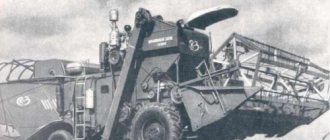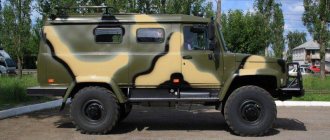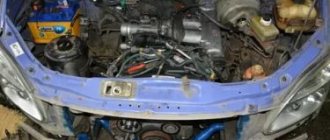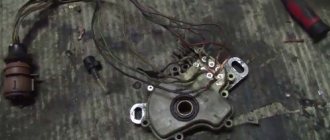The legendary GAZ 66 was produced in a series of about 1 million units throughout its history! There are still plenty of them in the storage warehouses of the Ministries of Defense of Russia, Belarus and Ukraine. From where they are removed every year after the storage period has passed and sold to everyone at open auctions.
They are especially in demand among fans of motorhomes (options with different types of kungs) for hunting, fishing, and travel.
See on our website through the “ Search ” line an interesting article: Motorhome on wheels and road trips .
In mountainous conditions, in resorts, in forests, swampy areas, in agriculture where there are no asphalt roads.
And for commercial use. Drilling rigs for installing power transmission poles, for delivering work crews and supplying them in hard-to-reach places. For towing welding machines, cable reels and similar equipment.
In general, this is truly a people's car!
The prototype and its brothers
Initially, it was created in Moscow in the famous NAMI as the NAMI 072 truck (1957!). They also created the famous NAMI 375 - aka the future URAL 375 petrol with a forced engine of 180 hp from the ZIL 130 (which initially had 150 hp). And later it is also the diesel URAL 375. There, NAMI will create the famous, but not yet able to reveal all its capabilities, unique universal all-weather truck NAMI 4540. A kind of continuation and more pragmatic replacement for the GAZ 66. For work in the fields in any weather! This is not always possible even for the technology that exists today.
Only then the NAMI 072 truck was transferred to the GAZ plant. Where they waited for the appearance of the new 8-cylinder ZMZ engine with a capacity of 115 hp (120 hp for the GAZ 53). And they launched it into a series called GAZ 66.
GAZ 66 was produced from 1964 to 1999. It was discontinued due to its obsolescence.
It was replaced by the GAZ 33097 Sadko with a hood cab and options with diesel engines.
Before the GAZ 66, the GAZ plant in Nizhny Novgorod also produced a hooded version of the GAZ 51 all-wheel drive - GAZ 63 with an in-line 6-cylinder petrol engine producing 90 hp.
All these cars and many others are presented in the GAZ plant museum.
Modernization and immediate retirement
Between them in the late 80s there was a version of the modernization of the cabover GAZ 66 from the plant. With air-cooled diesel engine, air brakes. Increased load capacity and cross-country ability. With a lot of innovations and amenities. But it didn’t go into series.
The experience of the Afghan war of 1979-1989 showed a number of shortcomings of cars of this type. In particular, the army will abandon the GAZ 66 and ZIL 131. Both initially had gasoline engines. Which, in the event of a fire, relatively quickly led to an explosion and detonation of the gas tanks. As a result, the crew and cargo died. Diesel trucks burned slowly, which made it possible to have time to leave the vehicle or pull out the wounded and those unable to get out on their own.
In addition, in the event of a mine explosion, unlike hooded trucks, the crew in the cabin either died immediately or received too serious injuries, contusions and disabilities. This was the main reason for the army’s refusal to use the rear-engined GAZ 66.
Therefore, quite quickly the gasoline trucks were sent back to the USSR or transferred to the Afghan security forces for their needs.
Secondly, by the end of the 1980s, increased gasoline consumption was no longer relevant.
In the new market realities and with a lack of funds for the development of new models, we had to adapt to the civilian consumer with the previously developed ones.
Standard box bodies
Standard box bodies
One of the most common military superstructures on the GAZ-66 chassis were numerous habitable van bodies of various types, designs and purposes, produced by specialized enterprises. At different times, they were equipped with rectangular wood-metal vans KUNG-2M produced by the Gazstroymashina association, frame-metal KUNG-66 and modernized rounded designs ABC-2M with trapezoidal wheel niches. Since the mid-1960s, the role of the main army vans began to be played by standard K-66 and KM-66 bodies with a spare wheel located on the rear folding bracket, specially designed for installation on GAZ-66 of different versions. They fully satisfied military requirements in terms of versatility, dimensions, dead weight, strength, safety level, adaptability to transportation by various means of transport and the use of external or autonomous energy sources, the possibility of effective operation in military operations and under the most severe road or climatic conditions. The bodies provided the placement of a variety of equipment, equipment or property, as well as the long-term stay of people in them, creating for them all the necessary conditions for effective activity and recreation. At the last stage of production of the GAZ-66, standard removable container bodies KK-1.1 and their extended versions KK-2.2 for universal use were developed for transportation on flatbed trucks.
Staff vehicle of the Internal Troops R-125MT2 in the body of an ABC-2M on a GAZ-66-05 chassis. 1966
K-66 is a series of the most common habitable frameless van bodies for the GAZ-66. Their initial design was developed in 1958 - 1960 at plant No. 38. Taking into account the increased requirements for such equipment, the Ministry of Defense in April 1967 adopted new “Tactical and technical requirements for the development of a family of unified van bodies made of reinforced polystyrene foam for cars, trailers and semi-trailers,” the further design of which was entrusted to the body department of the All-Union Design and Technological Institute of Furniture (VPKTIM) of the USSR Ministry of Forestry. Since 1968, their production has been carried out by the Shumerlinsky enterprise ShZSA, the Kozlovsky and Krasnogorsky van plants, as well as a number of pulp and paper and woodworking plants.
GAZ-66-04 with a low-profile inhabited frameless van body K-66N. 1967
Typical K-66 bodies had flat front, side and rear panels made of reinforced foam, a central part of the roof with characteristic flat bevels, short wheel wells and a rear double-leaf door measuring 1305x1570 mm with a narrow window. They were adapted for operation at extreme temperatures, using a 220 or 380 V power supply or an on-board 12-volt power supply, and were equipped with an OV-65B heater and an FVU-100N-12 filter-ventilation unit. K-66 bodies were produced in four modifications with different dimensions, internal volume and degrees of strength, number and location of windows, doors and hatches. The equipment of numerous military communications equipment, control machines and workshops of various profiles was installed in them. The most popular was the tall version of the K-66V with a payload of 1230 kg, a working platform on the roof and 12 hatch windows - three in the side walls and three skylights in the roof slopes. Its curb weight was 1280 kg. Internal length – 3680 mm, width – 2250 mm, height in the central part – 1800 mm, along the side wall – 1500 mm. Loading height – 1190 mm. Overall dimensions of the GAZ-66 car without a winch with a K-66V body are 6029x2400x3160 mm. The total weight of the van without a winch is 4300 kg, with a winch – 4470 kg. The second high version of the K1-66 was equipped only with a right side door, two windows on each roof slope and an internal intercom. In the army, vehicles with such bodies were used as buses to transport 19 people in individual seats. K-66N body with a payload of 1460 kg and an internal height of 1430 mm, more compact communications equipment was usually installed. Its variant was the K-66DS on the GAZ-66B landing chassis. The program also included extended versions of the K-66U1D and K-66U1-DP with increased internal volume, which were installed mainly on ZIL-157 vehicles.
KM-66 is a series of more durable and heavy frame-metal (all-metal) bodies with a payload of 1230 kg for mounting field workshop equipment, unified in size with the K-66 series. The KM-66 body was developed in 1964 and was produced until 1975 by the military plant PO Box 4111, which later became known as the Moscow Specialized Vehicle Plant (MZSA). Since 1970, it has been assembled by the Kozelsky Mechanical Plant in the Kaluga Region, then by the Lvov Mechanical Plant, and since 1978 by the Engels Specialized Vehicle Plant (EZSA). Compared to the K-66V bodies, the internal length of the KM-66 reached 4000 mm. The low-profile folding version of the KM-66DS was intended for the airborne GAZ-66B vehicle.
KUNG-66 is a multi-purpose frame-metal body of the second generation for target installation on the GAZ-66. In 1977 - 1983 it was assembled by the Kozelsky Mechanical Plant. The side walls of the body were insulated with foam plastic and lined with wood fiber boards on the inside; the floor was covered with plywood sheets on a foam pad. In the transport position, a removable rear ladder was placed under it. Unlike the KUNG-2M body, it was equipped with an OV-65B heating and ventilation unit and an FVUA-100 filter-ventilation unit.
GAZ-66 with a KSh-66 body of increased strength, developed at 21 Research Institutes. 1977
The most original experimental designs included special “super-streamlined” van bodies of Experimental Plant No. 38, developed by designers of the 21st Research Institute. In 1965 - 1967, prototypes of rounded fiberglass bodies KZ-1 , followed in 1972 - 1977 by the high-strength body (KPP) KSh-66 with an integrated cabin. Their emphatically streamlined shapes, close to spherical, predetermined the direction adopted at that time towards the creation of military vehicles resistant to the damaging factors of weapons of mass destruction. Compared to standard metal bodies, their resistance to the shock wave of a nuclear explosion was three times higher.
New life - new modifications
In the 1990s, both machines switched to diesel engines from the Belarus tractor. Modification of the D-245 with varying degrees of boost from 80 to 150 hp, but they also did not yield success. Including turbines and intake air cooling. Since the army, due to the sharp limitation of funding after the events in the USSR - Russia after 1991, already required universal vehicles. The army simply did not have enough funds to purchase all types of new trucks from all factories in Russia (UAZ, GAZ, ZIL, KAMAZ, URAL, BAZ), Belarus (MAZ) and Ukraine (KrAZ).
The military chose the diesel URAL 4320 and KAMAZ 4310 and their modifications. They had an excellent reserve of cross-country ability and carrying capacity, respectively. Again, the army still had huge reserves of GAZons and ZILs in reserve storage warehouses for another 20-30 years to come (see website Rosrezervy.rf).
Throughout the 1990s, cars that were about 20 years old were removed from storage warehouses and sold to everyone. Due to their already insufficient combat effectiveness due to wear of a number of components and decreased reliability. At first, due to the lack of funds for the purchase of new cars, they were taken by city utilities, enterprises, and rural services.
New previously unexpected consumers
And in the 2000s, when the population also had funds, the same GAZ 66 began to be purchased for business. Often these were tourism destinations in the south, bringing any bulk materials (sand, crushed stone, peat, firewood, etc.) for summer residents. For private households. Where it is difficult to get through, there are no normal roads, or there is not enough space to squeeze through to the desired unloading point.
And after that, literally anyone who wanted to take them began to take them. The selling price of a GAZ 66 from the army at an open auction, depending on the condition, now ranges from 150 to 400 thousand rubles. It's quite cheap. All-wheel drive car, at the price of a passenger car, with tire pressure adjustment from the cab, on a frame, with a connected front axle, a lowering row and self-locking differentials on both axles. With proper care, it is literally an eternal car that can always be sold at a profit or passed on by inheritance.
Someone replaced the standard engine with a diesel engine from Belarus - the most widespread and cheapest case. But it is noisy and does not like speeds above 70-80 km/h on the highway. And some simply installed LPG there as an even cheaper option to reduce fuel costs. There were also options with two injectors from the VAZ 2110. This also reduced consumption and eliminated the smell of gasoline evaporating from the carburetor. And the power increased a little.
STORY
The first prototypes of the GAZ-66 were created in 1962 as a further development of the 1.2-ton GAZ-62 truck, produced in 1958-1962. (extremely small quantities produced) and the successor to the 2-ton GAZ-63 truck, produced in 1948-1968. Serial production of the GAZ-66 began in July 1964. In 1968, the truck received a centralized tire pressure regulation system (66-01 and modifications).
In 1966 he was awarded a Gold Medal at the exhibition “Modern Agricultural Equipment” in Moscow. In 1967 he was awarded the Gold Medal at the International Fair of Agricultural Machinery in Leipzig. In April 1969, the GAZ-66 was the first Soviet car to receive the State Quality Mark. GAZ-66 was exported to all countries of the socialist camp.
The GAZ-66 was adopted by the Soviet army and was used in the national economy; after the collapse of the USSR, a large number of GAZ-66s began to be used in the Russian army, mainly in the Airborne Forces and border troops.
In 1995, mass production of the GAZ-66-11 with modifications was discontinued. In return, the Gorky Automobile Plant mastered the production of the GAZ-3308 “Sadko” model, unified with the GAZ-3307. The last copy of the GAZ-66-40 rolled off the assembly line on July 1, 1999. A total of 965,941 copies were produced. GAZ-66 family.
A new round of development
Others went further and installed used engines from Toyota 1UZ, 3UZ. And also from commercial trucks IVEKO, HINO, ISUZU, Mercedes.
About the capabilities of such a GAZ 66 with an engine from IVEKO, see the video below. It flies like a car, climbs everywhere like a tank.
Moreover, the majority left the manual transmission. The standard one has extremely poor gear shifting. You have to literally hold your right hand behind your back the whole time while riding. This was done for the sake of cheapness, simplicity and ease of lifting the cabin.
Some GAZ 66 cars were equipped with automatic transmissions, which fell into the hands of craftsmen along with the foreign used engines listed above.
Diesel D 245
After the end of production of GAZ 66 cars, the Gorky Automobile Plant again revived the production of diesel engines. The “66th” was replaced by the GAZ 3308 “Sadko”; in 2001 it received a Minsk Motor diesel engine; it is now relevant for the GAZ 66 car, it is often installed on it, making the necessary changes to the design.
Technical characteristics of D-245:
- Maximum power – 117-122 hp. With. (according to various sources), the number of revolutions at rated power is 2500 per minute;
- Number of cylinders – four, arranged in one row;
- Engine volume – 4.75 l;
- Torque (MAX) – 43.1 kgf•m;
- Compression ratio – 17.1;
- Standard piston diameter – 110 mm;
- Piston stroke – 125 mm;
- Type – turbocharged, water (liquid) cooling;
- Unit weight – 430 kg;
- The order of fuel supply to the internal combustion engine cylinders is 1-3-4-2;
- Fuel consumption – 13.5-17 liters per 100 km (at speeds of 40 and 60 km/h).
Device diagram and overall dimensions of the diesel engine D 245
Improvements for individual consumers
Many hobbyists began to buy GAZ 66 from storage and improve the car in a very modern way. In particular, its controls are moved to a more convenient place - to the front of the cabin. Plus the installation of comfortable seats, more reliable and powerful air brakes and everything else necessary for off-road and long journeys.
Now there are quite a few private companies that can do all this for you. See many options on YouTube. For example, Eduard Shabunya and his team. And often it will be cheaper than buying a new similar car. And forward and all-round visibility is simply ideal for narrow spaces. GAZ 66 can even be seen in parking lots in big cities, literally in the courtyards of multi-story buildings! They will squeeze through and go anywhere.
But finally, the plant saw what the Kulibin people from all the CIS countries were doing and decided to take the initiative into their own hands. Since there is obvious demand for such equipment for transporting cargo weighing up to 4 tons off-road literally everywhere.
DESCRIPTION
The car owes its high cross-country ability to self-locking differentials on the front and rear axles and tires with adjustable pressure
Front drive axle, power steering hydraulic cylinder visible. The ends of the springs are fixed between rubber “cushions”
The rear drive axle and cardan shaft crosspieces are protected by metal covers. The vacuum booster for the hydraulic brake drive is visible.
GAZ-66 is an off-road truck with a carrying capacity of 2 tons, designed for driving in difficult road conditions and off-road. High cross-country ability is due to the use of self-locking differentials on the front and rear axles, high ground clearance and adjustable tire pressure (the wheels have a special design); an engine-driven compressor is installed to inflate the tires. The car engine is equipped with a PZHB-12 pre-heater. The service brake system is hydraulic separate with a vacuum booster, the parking system is a drum transmission brake. Hydraulic power steering.
An important feature of this vehicle is the balanced location of the center of gravity, almost equal load on the front and rear axles and compactness due to the cabin above the engine, due to which the vehicle was widely used in airborne troops, as it lands on all wheels at once and descends without blocking the cabin. However, the limited internal volume of the cabin and its location directly above the wheels turned out to be dangerous for the crew in the event of a mine explosion, so the GAZ-66, starting in the 1980s, was withdrawn from combat units in Afghanistan. In the 1990s, the GAZ-66 was massively decommissioned from combat units; later it was replaced by the GAZ-3308 Sadko bonneted truck with a similar chassis, but longer.
To inspect the engine, the cabin is hinged forward; between the driver's seat and the passenger's seat there is a non-removable casing covering the engine; because of this, the curved gearshift lever is located to the right-rear of the driver, which causes some inconvenience when changing gears.
For the driver's rest, the GAZ-66 was equipped with a removable hanging canvas bunk, essentially a hammock, which was suspended on four hooks in the cabin.
The front and rear suspension was on longitudinal semi-elliptic springs with double-acting hydraulic telescopic shock absorbers; the GAZ-66 was distinguished by its smooth ride. Due to single springs on the rear axle and limited-slip differentials in the final drives, the car could not be overloaded.
The main plant also joined the trend
Now, starting from this year, automatic transmission will be installed on Sadko Next Lawn. The logic is simple: someone will be able to buy new ones.
And they cost around 5 million rubles. Over time, they, in the form of boos, will fall into the hands of folk craftsmen and those listed above. That is, they will become a replacement for the GAZ 66. And they will have at their disposal the cool, powerful, economical and quiet diesel engine YaMZ 536 with the entire component base of spare parts from Yaroslavl. And a domestic automatic transmission, produced at the GAZ plant itself. With full access to its spare parts.
A very smart step for the distant future. That is, you won’t have to look for foreign replacements. Let’s say right away that the plant has also prepared an electric car version for the future. And the Kulibins have already made fully electric versions based on the GAZ 66.
Below is a video review of the Sadko Next Lawn with automatic transmission. And all modern and promising GAZ models.









